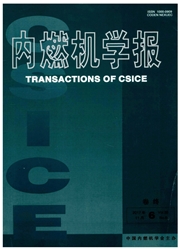

 中文摘要:
中文摘要:
将燃料理化特性参数依次分离,研究不同燃料特性在宽广废气再循环(EGR)范围内对柴油机燃烧和排放的影响规律.结果表明:试验选用的国Ⅳ柴油燃料,成份的改变如芳烃和硫含量降低对燃烧和NOx、THC、CO及碳烟排放影响作用很小.燃料沸点和黏度降低,预混放热峰值增大,碳烟排放降低;负荷增大后对碳烟降低作用减小.燃料沸点和黏度在中、低比例EGR率下对气体排放影响很小,在高比例EGR率下低沸点、低黏度燃料THC和CO排放较高.十六烷值是决定燃烧放热时刻的最重要参数,不同十六烷值燃料在高比例EGR率下对滞燃期影响更显著.十六烷值和含氧是降低碳烟两个决定性因素,孰重孰轻视燃料特性而定,不同十六烷值燃料的气体排放差异很小,只在低EGR率下随十六烷值降低,NQx排放略有升高.正丁醇分子结构较甲醇、乙醇、丁酸甲酯和2,5-二甲基呋喃(DMF)能更有效降低碳烟.
 英文摘要:
英文摘要:
Fuel properties were seperated to investigate the effect of fuel properties on combustion and emissions at wide range of exhaust gas recirculation (EGR)rates. Results show that, decreasing the aromatic content and sulfur content has slight effect on combustion and emissions of NOx, THC and CO. With the decrease of fuel boiling point and viscosity, the peaks of premixed combustion are increased and soot emissions are reduced, but the soot reduction rate is reduced at relatively high load. Gaseous emissions are similar at low and medium EGR rates, while THC and CO emissions are higher in the case of fuels with low boiling point and viscosity at high EGR rates. Cetane number is the dominant factor on the controlling of ignition timings. Cetane number and fuel oxygen are the two main factors for the reduction of soot. Gaseous emissions are similar for the fuels with different cetane numbers except at low EGR rate where NOx emission is increased with the decrease of cetane number. N-butanol has the largest soot reduction potential among the investigated fuels.
 同期刊论文项目
同期刊论文项目
 同项目期刊论文
同项目期刊论文
 期刊信息
期刊信息
